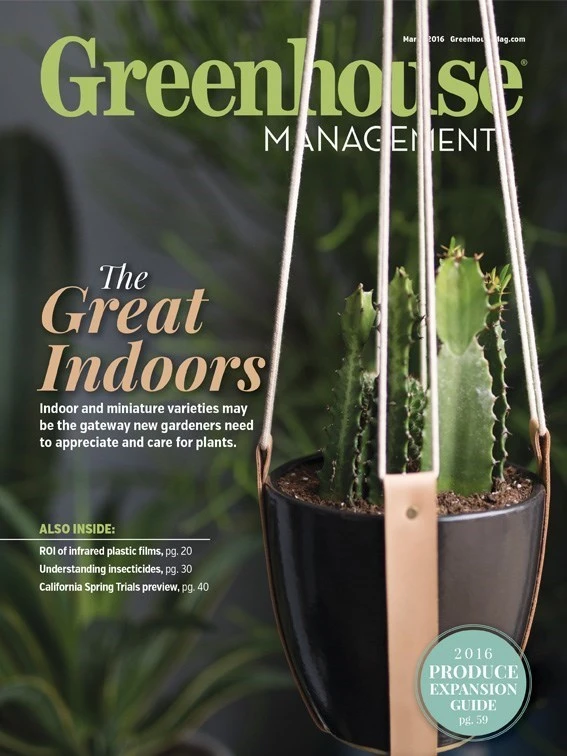
Although greenhouse films with infrared (IR) have been on the market for over 30 years, some growers are not taking advantage of the benefits of this material. More than half of the greenhouse operations that I have audited still have houses that are covered with regular poly. Let’s look at the benefits of IR greenhouse films:
Radiation is the process by which heat is transferred from one object to another. Energy from the sun enters through the greenhouse glazing as short-wave radiation and is converted to thermal energy (long-wave radiation) when the waves strike the plants, floors or benches. This energy is trapped by the glazing and the greenhouse warms up. This is the greenhouse effect.
At night, the reverse occurs. Up to 40 percent of the heat from the plants, floors and benches is reradiated. Glass is opaque to long-wave radiation losses, but polyethylene will allow up to 74 percent of radiation to go right through it unless a barrier is present. To retain this heat, manufacturers have developed an additive that is placed in the formulation that reflects the radiation back into the greenhouse.
Also affecting the radiation loss from the greenhouse is the condition of the sky that the greenhouse is radiating to. The weather forecaster talks about radiational cooling on clear nights. A clear sky is much colder than a cloudy sky; therefore, radiation losses are greater.
Achieving savings
Research has showed that an IR additive will give significant reduction in the radiation losses. In effect, the additive made the plastic similar to glass. When compared to conventional plastic, a savings of up to 35 percent was achieved under clear sky conditions on a cold night. The researchers concluded that over a heating season, the savings might average 15 to 20 percent. This will vary depending on where your greenhouse is located and the number of clear nights that occur.
IR film is readily available today at a very slight premium (about 2 cents per square foot) over conventional film. The recommendation is to use one layer of IR film placed as the inner layer. Doing this allows the wetting agent that is also included in most films to conduct the condensed moisture away.
Research also shows that leaf temperature was higher under IR film, especially on clear, cold nights. This several-degree increase may result in a slightly earlier crop, so scheduling may have to be adjusted.
What’s the payback?
Take a 25-foot-by-100-foot (2,500-square-foot) hoophouse covered with double poly. The greenhouse has double polycarbonate endwalls. The greenhouse is operated at 60 degrees Fahrenheit nights and located in a northern climate with 3,800 heating degree days (55-degree Fahrenheit base). We use the 55-degree Fahrenheit base as the 5-degree difference is made up from the daytime heat from the sun. This will give a close approximation of the seasonal heating cost. Assume a natural gas cost of $16.34/million btu’s (equivalent to $1.35/ccf ).
We will compare replacing the inside layer of conventional copolymer film (40-foot-by-100-foot sheet) with a layer of IR film. Both films have a four-year life span. We will assume a seasonal savings of 12 percent with the IR film.
When compared to conventional plastic, a savings of up to 35 percent were achieved under clear sky conditions on a cold night [with IR film].
Using 2015 catalog prices, the cost is $540 for the IR film and $460 for the conventional film a difference of $80 or $20 per year for the four years.
Natural gas use through the sheet of conventional poly =
= 0.000291 x 0.8 x 4000 sq. ft. x 3800 degree days = 3539 ccf
With the IR poly the savings of 12% = 425 ccf
Savings = 425 ccf x $1.35/ccf = $574/year

Payback = 0.035 years or 13 days
For fuel oil and propane at today’s prices, the payback is less than two weeks. There are not very many places where you can invest $20 and get a two-week return.
With such a short payback, we can conclude that most growers should be using IR/AC film, even if the greenhouse is operated only for the spring bedding plant season. Additional benefits may be a warmer leaf temperature and a shorter growing period.

Explore the March 2016 Issue
Check out more from this issue and find your next story to read.
Latest from Greenhouse Management
- Super Charged Moon Juice from Moon Valley Nurseries now available nationally
- 2025 Proven Winners Horticulture Scholarship applications now open
- How to improve inventory and shipping management in the greenhouse
- Leading Women of Horticulture: Anna Ball, Ball Hort, and Terri McEnaney, Bailey Nurseries
- GM CEA HERB Part 2: A guide to increasing the sowing density of culinary herbs
- GM CEA HERB Part 1: Best practices for producing culinary herbs in controlled environments
- USDA fires experts on invasive pests, including Asian citrus psyllid, chilli thrips
- CEA Alliance celebrates bipartisan introduction of Supporting Innovation in Agriculture Act





